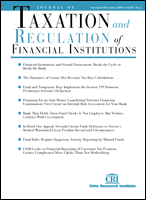Tax Shelter Disclosure and Penalties: New Requirements, New Exposures
Author: Mary A. McNulty.; Robert D. Probasco.
Source: Volume 18, Number 03, January/February 2005 , pp.26-35(10)

< previous article |next article > |return to table of contents
Abstract:
The IRS attacks abusive tax-avoidance transactions by challenging the tax treatment in individual audits and enforcement actions and by closing the loopholes that allow them. To be effective, these approaches both require information about tax shelter activity. Many abusive transactions are difficult to identify, and audits and enforcement actions may be ineffective because examiners often do not know where to look. Further, as quickly as the IRS closes loopholes, ingenious accountants and lawyers find new ways to exploit the complexity of the Internal Revenue Code. One of the primary weapons in the battle against tax shelters has been mandatory disclosure to the IRS. In 1984, Congress first required organizers to register tax shelters and to maintain investor lists. In 2000, Treasury imposed certain taxpayer disclosure requirements by regulation in an attempt to accumulate more information as part of annual tax returns. The American Jobs Creation Act of 2004 (“AJCA” or the “Act”)1 built on this approach, clarifying and making consistent the various disclosure and list maintenance requirements and strengthening penalties for non-disclosure. Unfortunately, to uncover every abusive transaction, Congress drew the boundaries of the disclosure scheme very broadly. As a result, the new rules cover legitimate tax planning transactions in addition to abusive tax shelters. This article focuses on three aspects of the new rules that make them particularly dangerous: the transactions covered, the participants covered, and the harsh penalties that apply for non-disclosure. The article begins with a discussion of the old disclosure, registration, and list maintenance rules and ends with a discussion of other significant provisions in the Act.Keywords:
Affiliations:
1: Thompson & Knight L.L.P; 2: Thompson & Knight L.L.P.